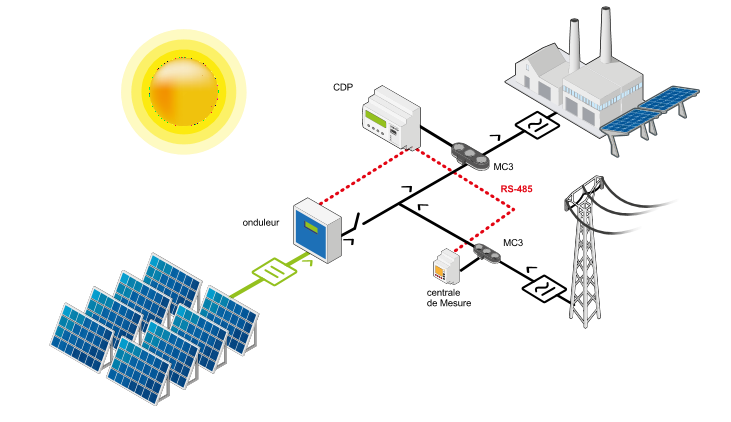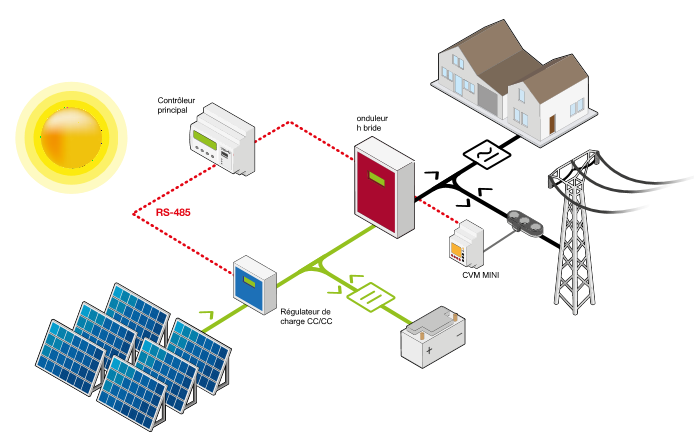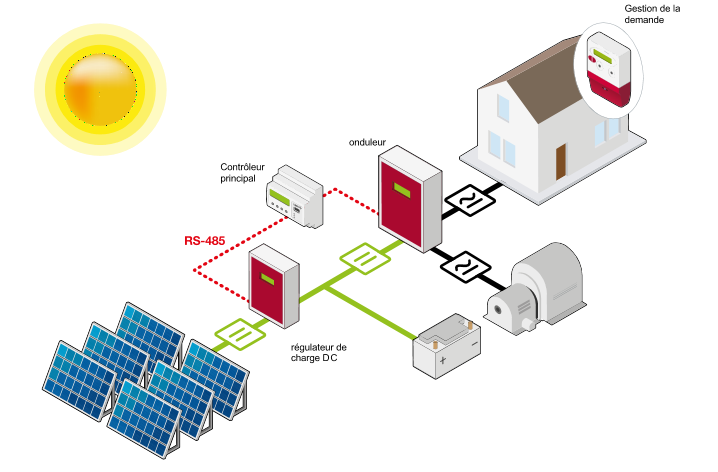Solutions for the production of photovoltaic electrical energy
Rentabilisez vos terrasses et terrains inoccupés

Quick return on investment: from 4.5 years

Possibility of financing the investment (from 250 kWp)
Active in the field of renewable energies for about ten years, Elexpert has accumulated a great experience in medium-sized Photovoltaic installations: from a few kW to 1MW, rewarded by obtaining the TAQA PRO PV+ label in March 2019.
We carry out all types of photovoltaic energy production installations: self-consumption installations connected to the low or medium voltage grid (on-Grid) with instantaneous consumption and limited injection to the public grid, self-consumption installations connected to the grid with energy storage and partially or totally deferred consumption, installations for isolated sites (off-Grid) with energy storage, centralized photovoltaic installations for outdoor lighting, etc.
We have also developed very high level solutions, combining photovoltaic and wind energy, with energy storage, and instantaneous or deferred consumption.
All our plants are equipped with monitoring and power monitoring systems developed in-house, enabling operators to monitor their plants continuously and get the most out of them.
What differentiates us from other players in the market is our ability to develop customized solutions and architectures, taking into account the hazards and specificities of each installation, and capable of providing real added value to the customer, helping him to make the most of his installation over time.
Our expertise in power quality is a key asset when it comes to installing renewable energy solutions in industrial environments with high levels of harmonic pollution, frequent power supply interruptions, or special reactive energy compensation solutions.
Our solutions are adapted to all types of equipment, regardless of the manufacturer, which allows us to integrate several brands of inverters, chargers, meters, weather stations, etc. in the same installation and monitoring system.
With its high level of expertise and equipment, our after-sales service is a major asset, and our remote monitoring and surveillance services will help you make the most of every installed Watt of your photovoltaic plant.
Benefits of our solutions
- Any type of photovoltaic installation: roof top, ground mounted, surface mounted, …
- PPA (Power Purchase Agreement) or EPC (customer financing of the project)
- Guarantee on the producible
- Sizing based on measurements of your current consumption (network analysis)
- Customized systems for limiting injection to the public grid
- Consideration of power quality phenomena (harmonics, outages, power factor, etc.)
- Monitoring solution adapted to your specific needs, allowing a very precise follow-up of productions, consumptions, yields, etc.
- Local server (at home) or on the cloud
- Integration with your energy management system, for monitoring all energy flows
- Power quality monitoring: harmonics, outages, etc.
- Real-time performance ratio monitoring: timely maintenance in case of panel clogging, string or module problems, fuse meltdown, deliverability, etc.
- Customized and on-demand weather station
- Integration of infrared thermography cameras for monitoring failures in panels
- Remote monitoring and maintenance service
- –
Our solutions for the production of photovoltaic electrical energy
This type of solar installation allows the integration of the photovoltaic system in factories and buildings as an inherent part of its internal electrical network, thus becoming an element of energy saving and not a power generation plant that would require certain capacities of evacuation to the network to which it would have been connected.
It is the ideal solution for buildings and industries with significant electricity consumption during the day. The photovoltaic plant becomes an integral part of the electrical installation, allowing to reduce the electrical bill significantly (30% on average).
A dynamic power controller adapts at any time the maximum production power of the photovoltaic inverters to the power consumed by the installation. In this way, the non-injection of excess energy into the grid is ensured, or the injection of the fraction of power that the legislation of the country concerned allows.
Grid-connected facilities can improve their degree of self-consumption of photovoltaic energy by interposing batteries to store excess energy during sunny hours for later consumption. In these systems, the control of the battery charge and discharge plays a crucial role since it manages the energy flows between all the elements of the installation. In this way, the system automatically consumes in a direct form during the day, stores the surplus in the battery and finally reduces the consumption of the grid during the night or during the hours of low sunlight, discharging the battery.
Grid-connected facilities that already have a photovoltaic production system can divert part of the solar production to be consumed during periods of low sunlight. In these systems, the control of the charge and discharge of the battery reduces or even eliminates the diurnal surpluses that could be exported to the grid, as well as reducing the power peaks requested from the public grid, through the injection of power from the storage system. This also reduces the subscribed power or at least avoids exceeding it.
This type of installation allows the electrification of places not connected to the public distribution network, such as rural dwellings, agricultural farms, bed and breakfasts, telecommunication sites, broadcasting stations or radio or television transmission, etc.
When there is a risk that the needs of the installation sometimes exceed the capacity of the photovoltaic power plant (due to the installed power, insufficient battery capacity, or unfavorable weather conditions), emergency generators are installed in order to supply the installation when the level of discharge of the batteries reaches a certain limit. Intelligent storage and demand management improves the efficiency of the system and minimizes the use of the backup generator.




